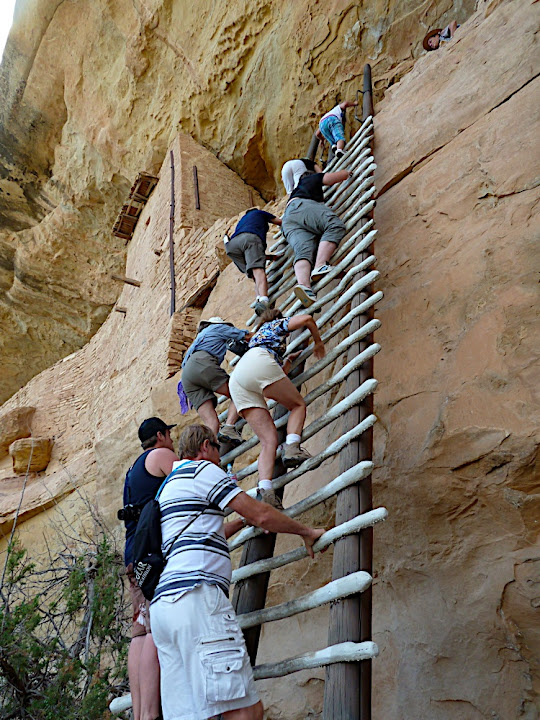anasazi
Anasazi or Ancestral Pueblans as modern Pueblo Indians prefer to call them lived in the Mesa Verde for hundreds of years until late 1200s. And then they disappeared. More exactly they stopped building. Quite abruptly as testified by an unfinished Sun Temple. And similarly they abandoned the Chaco Canyon about hundred years earlier.
What happened to them? Why did they leave? Where did they go? Professional and amateur archeologists have been attempting to answer those questions for 120 years now. No theory is entirely satisfying. For various reasons including political. Overpopulation and depletion of resources, advocated by Jared Diamond, doesn’t gel with the myth of Indians as good stewards following Mother Earth principles. When it is presented to Mesa Verde visitors it’s qualified by the occurrence of an ice age at that time. Drop in temperature is strangely at odds with artists’ renderings of mostly naked Indians peppering the park sites. But naked means savage and we, the descendants of the European settlers, are used to this excuse of the atrocities committed in the name of civilizing the indigenous population. Scholars disagree if it was great drought or ice age that explains the worsening of climate and forced the natives out. But you’d never know there is a controversy by reading literature provided by National Park Service.
NPS seems to have developed a really serious case of political correctness. They don’t advance any theories trying to navigate between sensibility toward Indians, respect of accomplishments of the early proponents of preservation, and expectations of the general public. The descriptions both written in booklets and presented by rangers guiding the tours concentrate on the obvious: this type of wall precedes that type, back rooms were used for storage, there are 23 round subterranean structures called kivas in this site, some sites have towers connected to kivas by tunnels. Purpose of kiva? Ceremonial of course. In the national park parlance it seem to be a fancy way to say we don’t know. In the case of kiva it may be a plausible theory as at modern pueblos this is a room (rectangular though) with a fire pit used for meeting and ceremonies. Of which the Indians are quite secretive. But does it mean it was used as such a thousand years ago? There is a trend to use churches nowadays as concert halls instead of prayer houses. If that trends prevails will we consider people in the middle ages unusually musical since they had so many music venues?
Maybe we are just having a bad ranger day, but our guides in Mesa Verde are way below the average NPS standard. I do not really expect to be entertained when I visit National Park, but they are clearly putting their comedians hats on most of the time. It’s as if they are trying to make up for inevitable disappointment. The ruins are impressive if seen in a context. They were build by people who just managed to discovered farming. Measured by a European timescale they are more like 15 thousand years old. But such context is exactly what’s missing from the offered explanation. What’s not missing unfortunately are not so good jokes about role of women in the society, appeals to our emotional side with invitations to share how the ruins make us feel and the pressure of 50 people trying to squeeze in the same narrow passage behind you. At some point I catch myself hoping that someone actually falls from the precipitously attached ladders to provide some distraction. Yeah, I am a terrible person. I am trying to engage a young ranger in some kind of deeper conversation but she toes the official line. When I try to make a comparison with Gila Cliff dwellings we visited in New Mexico she admits she never heard about them. Well, let’s be generous and blame it on my pronunciation. After a brief moment she is forced to shoo a big guy of an ancient wall who despite frequent warnings decides to sit on it. I start to feel less annoyed and more sorry for her.
The ranger points to an excellent defensive position of one of the dwelling: so called Balcony House. I ask if there is any evidence of actual fights and she firmly denies. On the other hand the park newsletter describes latest finding of an intact prehistoric knife with traces of animal and human protein. No suggestion of possible warfare though. Another controversy that NPS is not inclined to discuss.
The official position now is that modern Pueblo Indians are descendants of Anasazi, hence the term Ancestral Pueblans. I have a huge sympathy towards the modern members of the Pueblo tribes, and it makes sense for them to claim it. But if there is a scientific research that supports this theory NPS manages not to mention it.
The life style of modern Pueblans was irreversibly changed when they met Spaniards: oppression, suppression, imitation, resistance, not to mention time, all took toll and mutated original customs and beliefs. So we can’t exactly use their stories as explanation. We can’t follow the early archeologists either as their view of preservation involved using Portland cement and tossing aside anything that didn’t fit their vision. What are the chances they were wiser in the explanation department? I would gladly learn conflicting and controversial theories of contemporary archeologists while touring the park alas NPS deems general public not sophisticated enough to distinguish between theory and official position of the American administration (which NPS is a part of).
